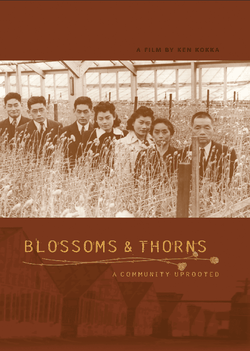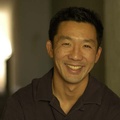Richmond, California, in the year 1942 calls to mind the bustle of naval shipyards and a whirlwind of housing construction. A semi-rural town before World War II, the city was forever changed by the war and the thousands of defense workers who migrated there to work in various wartime industries.
Another story, that of Richmond’s Japanese American residents and their cut-flower nursery businesses, is less well-known. An early twentieth-century immigrant success story, many of these families lost their homes, farms, and businesses when they were forcibly relocated and incarcerated by the federal government during World War II.
The documentary film Blossoms and Thorns: A Community Uprooted (Kokka 2012) reveals the contradictions between these two experiences of wartime Richmond by bringing Japanese Americans into the frame to tell their stories. With help from archival images and contextual comments from historian Donna Graves, the interviewees provide both an effective overview of Japanese American history and a personal, emotional record of this specific community and industry.
Despite discriminatory legislation that barred Asian immigrants from owning land or becoming citizens, early Japanese immigrants who settled in Richmond were able to establish a successful livelihood growing blossoms for San Francisco’s cut-flower trade. The film’s Nisei interview subjects, Tom Oishi, Flora Ninomiya, and Ruby Adachi Hiramoto, describe a tight-knit and ethnically diverse community in pre-war Richmond.
“In San Francisco, they were all restricted blocks…so the Japanese more or less have to stay together. But here in Richmond, I felt, being the son of an immigrant, being in business, I felt that I was good as the next man,” recalls Tom Oishi.
Shortly after the United States’ entry into World War II President Roosevelt signed Executive Order 9066, which barred 120,000 Japanese Americans from living on the West Coast and caused them to be moved to relocation centers away from the coast. Richmond residents had less than thirty days to wrap up a generation of business affairs before being sent to camps in Amache, Colorado and Topaz, Utah. In the film, the interviewees spoke about the traumatic impact this experience had on their families. Life in camp was characterized by crowding, bad food, lack of privacy, extreme weather, and the presence of armed guards.
“Topaz is a nothing place, nothing for miles…you had to make your own happiness,” remembers Hiramoto.
In addition, some families, such as the Ninomiyas, dealt with prolonged separation from relatives who were being held in separate army prison camps. Still others had children fighting overseas in the United States army.
Amid these hardships, the documentary also reveals stories of friendship and resilience. In addition to the Nisei interview subjects, Kokka was able to interview Francis Aebi and Linda Aebi Hale, who lived near the Ninomiya family as children. During the war, the Aebi family looked after the Ninomiya nursery while their neighbors were in camp, a gesture of solidarity that appears to have had a profound impact on the siblings even later in life. Flora Ninomaya expressed gratitude for this state of affairs.
“We did have our home to come to, had our nursery to come to, and in that manner we were very, very fortunate, because it was in perfect condition, because the Aebis had taken care of our place,” she says.
Upon their release from camp at the end of the war, most other Japanese American families found that their homes, businesses, and savings had been destroyed. In Richmond, the flower growers found their greenhouses shattered and their plants missing. In the film, Hiramoto describes sifting through the greenhouse soil with chopsticks to remove broken glass in preparation for the planting of new rose bushes.
Despite these setbacks, once resurrected, the cut-flower business flourished for decades more until it became impossible to compete with other growers.
* * *
In 2006 the site of the remaining Richmond nurseries was purchased by the Richmond Community and Economic Development Agency, providing the impetus to preserve the nursery story, according to film director Kenneth Kokka. A native of nearby Berkeley, California, Kokka was approached by the Contra Costa Japanese American Citizens League for the project after he made The Chessmen, another short film related to Japanese American nursery businesses. Working on The Chessmen gave Kokka an opportunity to explore the experiences of his own parents and grandparents after incarceration. He says that making Blossoms and Thorns further impressed upon him the importance of capturing these stories “while we still have the chance.”
“Nisei in particular tend to be modest and self-effacing, so it takes a bit more effort to draw them out, but it’s worth the time to preserve their voices,” he says.
Kokka hopes that viewers “will walk away with a sense of what it might have felt like to have experienced internment themselves.”
“I was particularly taken by Tom Oishi’s story, in part because I have a hard time imagining how I might have reacted as a young, vibrant American man in my twenties to a forced, unjust relocation.”
One surprising aspect of the project for the director has been screening the film for audiences with “little-to-no familiarity with this history.”
“This is stunning but not surprising, really; shameful governmental decisions have a way of being swept under the rug,” Kokka observes. “If we don’t speak up and speak out about these experiences, they may well be neglected and eventually forgotten by the public as a whole.”
Blossoms and Thorns debuted at the Rosie the Riveter Homefront Visitor Center in August 2012, and the film will continue to be presented weekly to park visitors, alongside information about the women who came to work in the Bay Area shipyards during the war. Currently, work is underway to rehabilitate the former nursery site from the effects of pesticides and to replace some of the structures with affordable housing units and open space. A few of the original nursery structures, including a greenhouse and water tower, will be restored and preserved.
Although the nursery land will now flourish for new generations and a new purpose, its former residents and their struggles will not be forgotten.
* In addition to weekly screenings at the Rosie the Riveter Homefront Visitor Center in Richmond, California, Blossoms and Thorns will have several additional screenings in early 2013. If you are interested in viewing the film or screening it for a group, please contact the Contra Costa Japanese American Citizens League at contracostajacl@gmai.com.
To read a more extensive interview with director Kenneth Kokka >>
* * *
Film Screenings
Blossoms and Thorns: A Community Uprooted by Kenneth Kokka
Saturday, February 2, 2013 • 2PM
Japanese American National Museum
Los Angeles, California
The film is also available for purchase through the JANM online store >>
© 2013 Japanese American National Museum








